Arthur Cronquist was the Senior Curator of New York Botanic Garden and Adjunct Professor of Columbia University. He presented an elaborate interpretation of his concept of classification in The Evolution and Classification of Flowering Plants (1968), The further edition of his classification was published in “An Integrated System of Classification of Flowering Plants” (1981). In general which is known as Cronquist’s system of classification.
The latest revision was published in the 2nd edition in 1988 in “The Evolution and Classification of Flowering Plants”. Ne discussed a wide range of characteristics important to phylogenetic system. He also provided synoptic keys designed to bring the taxa in an appropriate alignment He also represented his classification in charts to show the relationships of the orders within the various subclasses. His system is more or less parallel to Takhtajan’s system. but differs in details.
He considered that the Pteridosperms i.e., the seed ferns as probable ancestors of angiosperm.
Principles of Classification
- The earliest angiosperms were shrubs rather than trees
- The simple leaf is primitive than compound leaf.
- Reticulate venation is primitive than parallel venation.
- Paracytic stomata is primitive than the other types.
- Slender, elongated, long tracheids with numerous scalariform pits are primitive. Further specialisation leads to shorter broad vessels with somewhat thinner walls and transverse end walls with few larger perforations. Later on, the perforation becomes single and large.
- Long and slender sieve elements with very oblique end walls where the sieve areas scattered along the longitudinal wall with groups of minute pores are primitive. Whereas, the phloem with short sieve tube elements where end walls having a single transverse sieve plate with large openings is a derived condition.
- The area and activity of cambium and also the length of fusiform initial is more in primitive form which gradually becomes reduced in advanced one.
- Plants with vascular bundles arranged in a ring are primitive rather than scattered vascular bundle as found in monocots.
- Plants with large and terminal flowers are primitive, those may arrange in monochasia or dichasia and the other type of inflorescences have been derived from these types.
- Flowers with many large, free and spirally arranged petals: in any linear and spirally arranged stamens and free carpels as found in Magnoliaceae are primitive, and other types got evolved through gradual reduction, aggregation, elaboration and differentiation of floral members.
- Plants with unisexual flowers are evolved from bisexual floral ancestors
- The large and indefinite number of floral members are primitive than the small and definite numbers
- Androecium with many stamens is primitive than the reduced numbers,
- Linear stamens with embedded pollen sacs as found in some Magnolian genera are considered more primitive than the others.
- Uniaperturate pollen grains are considered as primitive and the triaperturate type are derived from it.
- Insect pollinated plants are considered as primitive from which wind pollinated plants got evolved
- The gynoecium comprising of many carpels arranged spirally on a more or less elongated receptacle is considered as primitive. Further evolution leads to the reduction of the number of carpels which are arranged in a single whorl and then undergo further fusion.
- Axial placentation is primitive from which other types have been evolved
- Anatropous ovule is primitive from which other types have been evolved.
- Ovule with two integuments (bitegmic) is primitive and, either by fusion or abortion, unitegmic condition has been evolved.
- Embryo-sac with 8-nuclei (Polygonum-type) is primitive from which embryo-sac with 4 nuclei (Oenothera-type) has been derived through reduction.
- Monocotyledons have been developed from dicotyledons through abortion of one cotyledon.
- The follicle (fruit) is considered as primitive. Further, dry and dehiscent fruit is more primitive than fleshy and indehiscent fruit.
According to him “many of the evolutionary trends bear little apparent relation to survival value and that there are some reversals”
In 1981, he divided the Division Magnoliophyta (Angiosperms) into two classes Magnoliopsida (Dicotyledons) and Liliopsida (Monocotyledons). He divided Magnoliopsida into 6 subclasses and 55 orders, of which Magnoliales is the primitive and Asterales is the advanced taxa.
On the other hand, the class Liliopsida has been divided into 4 subclasses and 18 orders, of which Alismatales is the primitive and Orchidales is the advanced taxa. The class Magnoliopsida consists of 291 families and Liliopsida with 61 families.
Cronquist Classification outline

Merits and Demerits
Merits
- There is general agreement of Cronquist’s system with that of other contemporary systems like Takhtajan, Dahlgren and Thorne.
- Detailed information on anatomy, ultra structure phytochemistry and chromosome morphology was presented in the revision of the classification in 1981 and 1988.
- The system is highly phylogenetic.
- Nomenclature is in accordance with the ICBN.
- The family Asteraceae in Dicotyledons and Orchidaceae in Monocotyledons are generally regarded as advanced and are rightly placed towards the end of respective groups.
- The relationships of different groups have been described with diagrams which provide valuable information on relative advancement and size of the various subclasses.
- The family Winteraceae (vessel-less wood present similar to Pteridosperms) placed at the beginning of dicotyledons is favoured by many authors.
- The subclass Magnoliidae is considered as the most primitive group of Dicotyledons. The placement of Dicotyledons before Monocotyledons finds general agreements with modem authors.
- As the text is in English, the system has been readily adopted in different books.
Demerits
- Though highly phylogenetic and popular in U.S.A., this system is not very useful for identification and adoption in Herbaria since Indented keys for genera are not provided.
- Dahlgren (1983, 89) and Thorne (1980, 83) treated angiosperms in the rank of a class and not that of a division
- Superorder as a rank above order has not been recognised here, though it is present in other contemporary classifications like Takhtajan, Thorne and Dahlgren.
- The subclass Asteridae represents a loose assemblage of several diverse sympetalous families.
- Ehrendorfer (1983) pointed out that the subclass Hamamelidae does not represent an ancient side branch of the subclass Magnoliidae, but is remnant of a transition from Magnoliidae to Dilleniidae, Rosidae, and Asteridae.
- There is a difference in opinion with other authors regarding the systematic position of some orders like Typhales, Arales. Urticales etc.
Related Articles
Revised by
- Md. Siddiq Hasan on August 12, 2020.
- Abulais Shomrat on 13 November, 2021.
 Plantlet The Blogging Platform of Department of Botany, University of Dhaka
Plantlet The Blogging Platform of Department of Botany, University of Dhaka






thanks a lot for information
You are welcome
nice